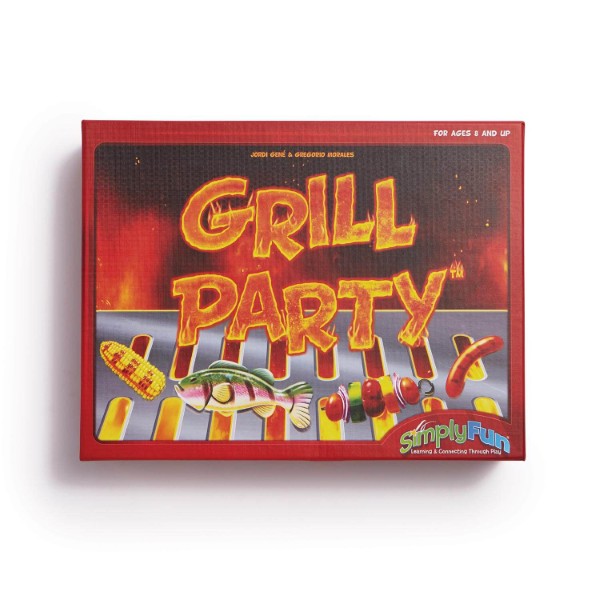
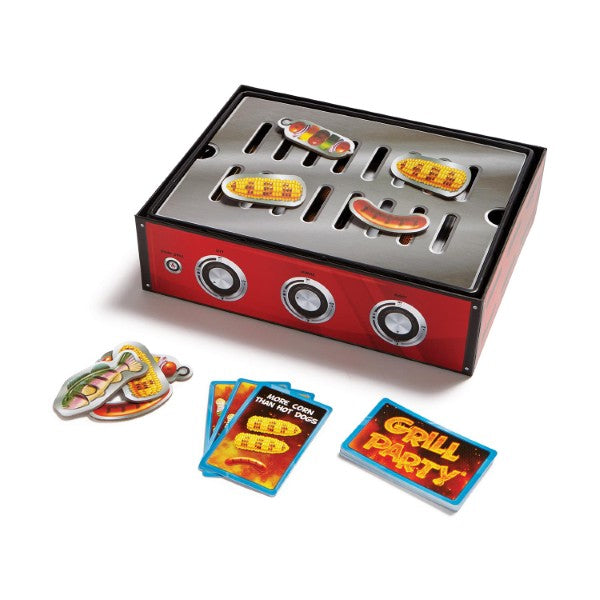
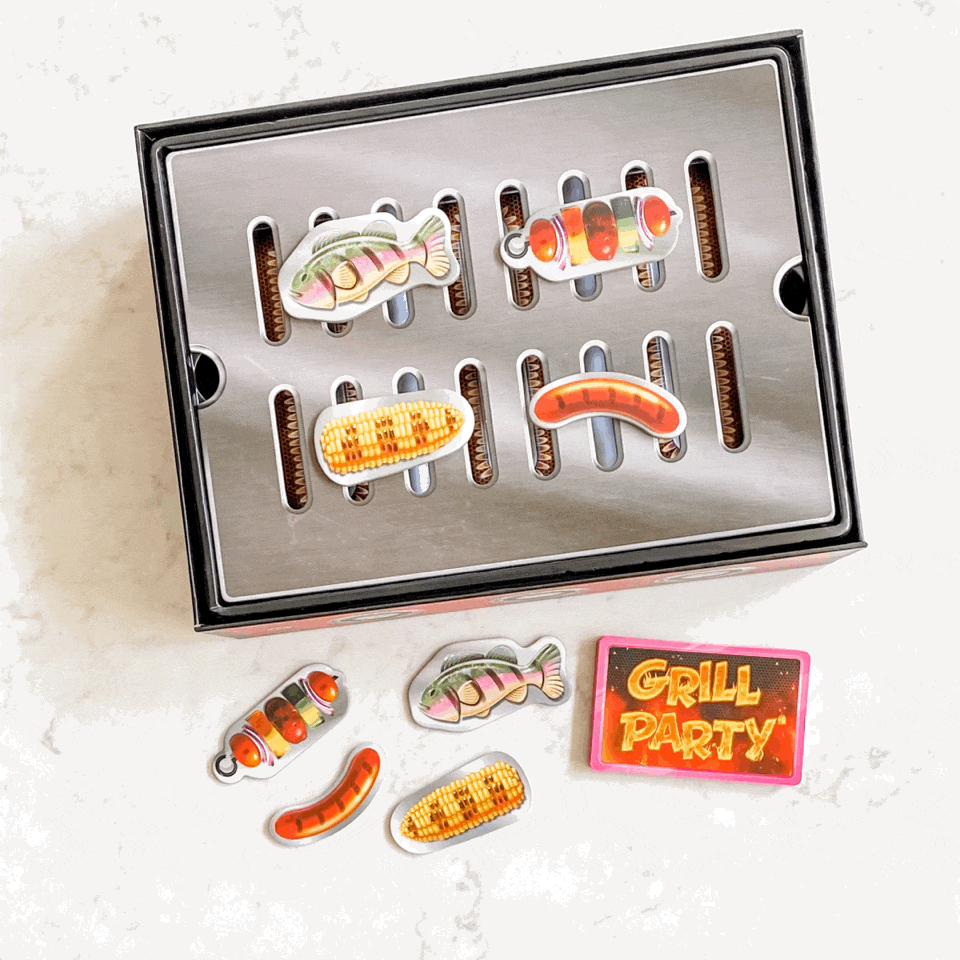
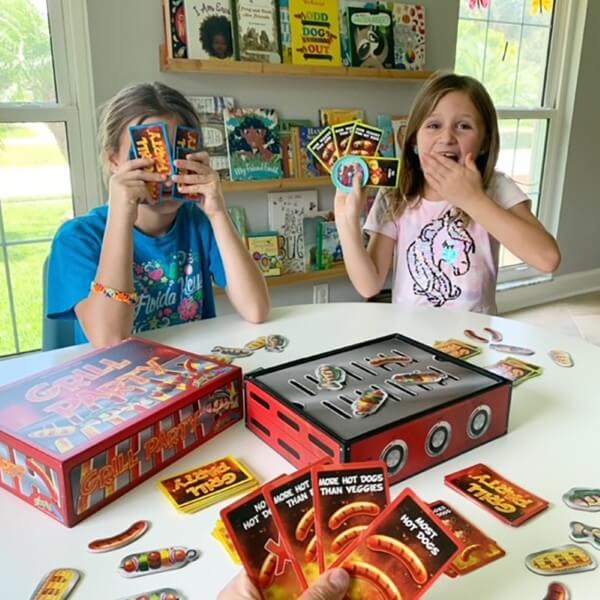
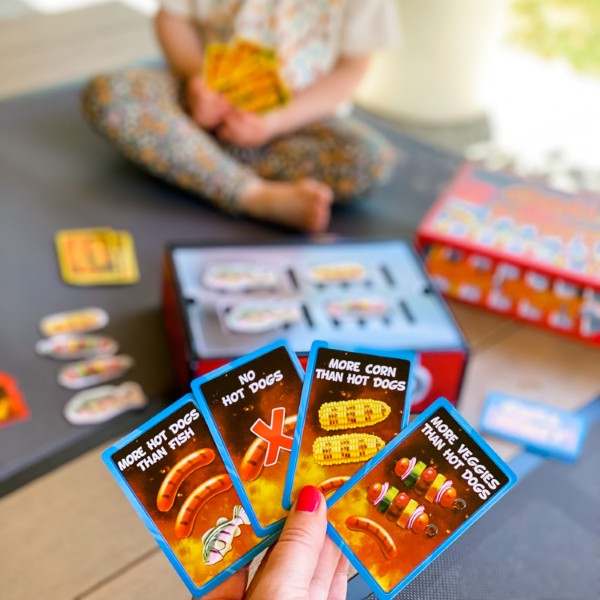
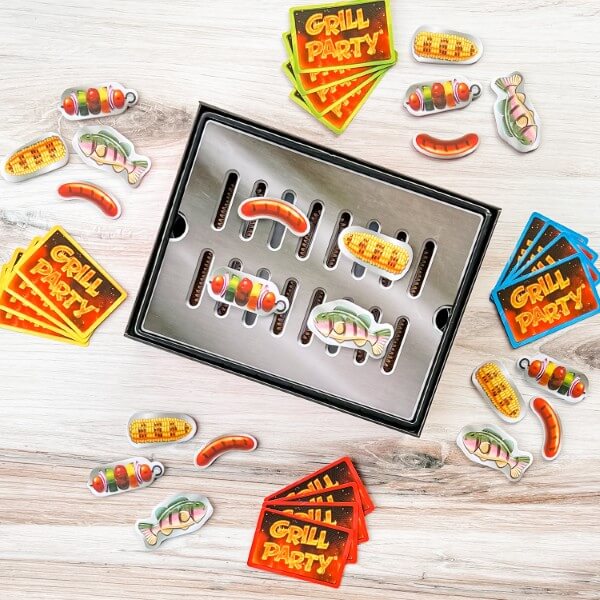
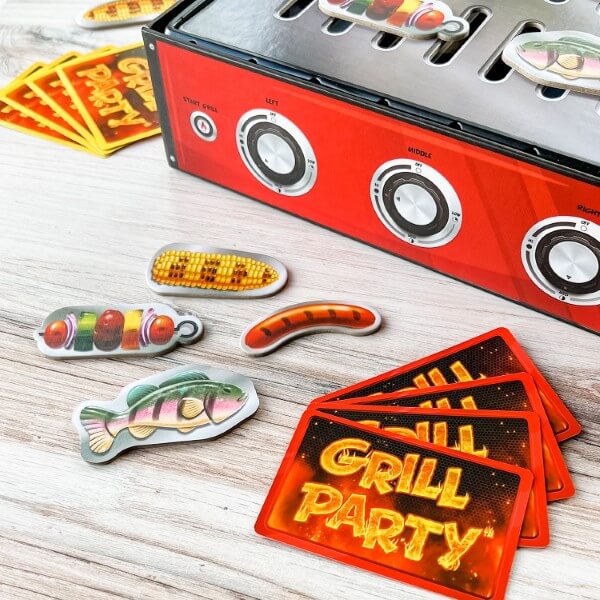


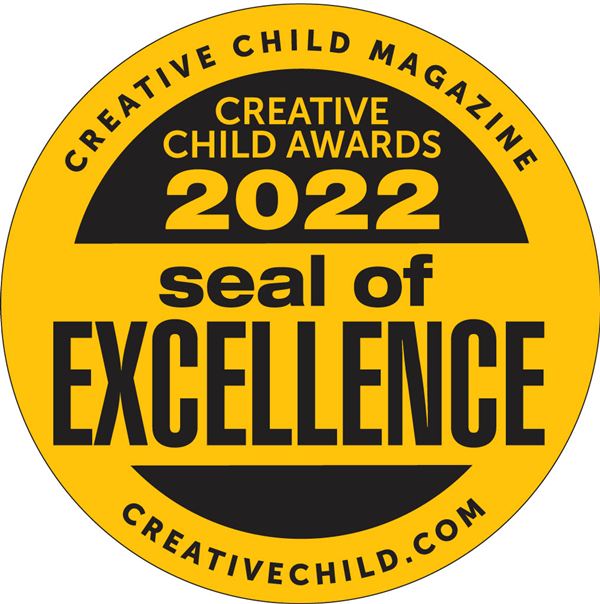
Collapsible content
BBQ your way to stronger math comparative skills as we choose what’s on the grill and learn how to play Grill Party.
You can play Grill Party with 2 to 5 players, ages 8 and up.
The Grill Party game box has everything you need for your own BBQ. There are 100 Grill Food Cards, 20 each of 5 different colors.
There are also 24 double-sided grill food pieces – 6 ears of corn, 6 hot dogs, 6 veggie skewers and 6 fish.
Finally, there is one grill board, and 1 flame board which help you turn you game box into a visually flaming grill! . Some assembly required!
Grill Party is a great way to help kids visualize math comparatives like more x than y, most of x, or none of Y. Grill Party also involves planning ahead on how to create the perfect grill contents to let you use the most of your cards during any one turn.
To set up the game, take all the pieces out of the game box, and place the box in the middle of the table within reach of all the players.
Then, distribute a set of 20 Grill Food Cards, all with the same border color, to each player. Players then shuffle their cards and place them face down in front of them to form individual draw piles.
Next, give each player a set of 4 starting Grill Food Pieces, one hot dog, one corn, one fish and one veggie. Give the “Grill” 4 Food pieces too, just like the players. These will be placed on top of the Grill Board after it’s assembled.
Finally, assemble the Grill: place the flame board in the game box base. Then place the grill board on top of the flame board. And finally, put the grill’s food pieces on the grill board.
Now. All players draw 4 food cards from their draw piles.
Let’s talk about the grill food cards for a minute. There are three different formats, and we’ll talk about them in terms of algebra. There are 4 “NO X” cards that can be played during a turn when NONE of the food on that card is on the grill.
There are 4 “MOST X” cards that can be played if there is MORE of the food pictured on the card on the grill than any other item.
And there are 4 “MORE X THAN Y” cards that are played when there is at least ONE MORE of one food on the card than there is of the other food. For this card, it doesn’t matter if the “less than” food is no on the grill; it may be completely absent.
Now, the game begins with the first player.
During a turn, a player MUST do the following things in the following order below:
1. First, swap one of his own grill food pieces with a piece on the grill OR from another player’s supply (like this). Note that he can’t do an “even food swap” – like fish for fish.
2. Next, play up to four grill cards in his hand that match the situation on the grill (as shown).
3. And finally, draw cards from his draw pile until he has 4 cards in his hand again.
The object of the game is to get rid your game food cards by matching them to situations on the grill. There will always be 4 food pieces on the grill but the number and type of food will change during the course of the game. Players may play up to four cards during a turn but at the end of the turn, they must draw enough cards back to equal 4.
Play continues until one player plays all his grill food cards from his hand and his draw pile. The first play to do this is the winner and is crowned the Grill Master!
To play a more challenging version of the game, refer to the instruction booklet for the variation.
So turn up the flames for the most fun with no smoke and have some fun with Grill Party!

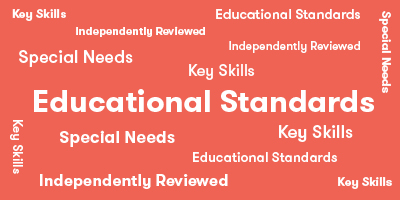
Core Standard*: None

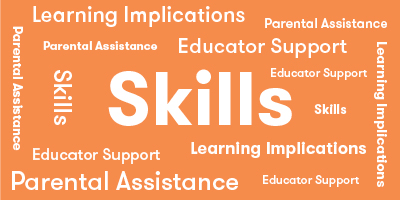
Explore
What Does Child Do To Use Skill In The Game?
On their turn, players look at the Grill Food Tiles on the Grill and in other players' hands; as well as review the four Grill Food Cards in their hand.
How Parents Can Assist Learning
Children may need to be reminded to look at the Grill Food Tiles of opponents when deciding what tile to swap from their hand. Also, allow children to rearrange the Grill Food Tiles on the Grill to help them examine their options.
Learning Implications and Educator Support
Children may need to be reminded to look at the Grill Food Tiles of opponents when deciding what tile to swap from their hand. Also, allow children to rearrange the Grill Food Tiles on the Grill to help them examine their options.
Determine
What Does Child Do To Use Skill In The Game?
On their turn, players need to determine what Grill Food Tiles to swap in order to maximize the amount of cards they can discard.
How Parents Can Assist Learning
Children may need to be reminded to look at the Grill Food Tiles of opponents when deciding what tile to swap from their hand. Also, allow children to rearrange the Grill Food Tiles on the Grill to help them examine their options.
Learning Implications and Educator Support
Grill Party is excellent for helping children develop pattern recognition, mental modelling and sequential thinking skills. On each turn, children will be looking at the Grill Food Tiles on the Grill, in their hand and in their opponents' hands in order to decide on the best tiles to swap that can let them discard the most (up to 4) cards. Players need to watch the sequence of changes on the grill and modify their thinking with each play.
Children may need to reminded to look at the Grill Food Tiles of opponents when deciding what tile to swap from their hand. Also, allow children to rearrange the Grill Food Tiles on the Grill to help them examine their options.
Compare
What Does Child Do To Use Skill In The Game?
In Grill Party, Compare is closely tied to Determine. Players need to compare all the Grill Food Tiles in order to determine what Grill Food Tiles to swap in order to maximize the amount of cards they can discard.
How Parents Can Assist Learning
Children may need to reminded to look at the Grill Food Tiles of opponents when deciding what tile to swap from their hand. Also, allow children to rearrange the Grill Food Tiles on the Grill to help them examine their options.
Learning Implications and Educator Support
Grill Party is excellent for helping children develop pattern recognition, mental modelling and sequential thinking skills. On each turn, children will be looking at the Grill Food Tiles on the Grill, in their hand and in their opponents' hands in order to decide on the best tiles to swap that can let them discard the most (up to 4) cards. Players need to watch the sequence of changes on the grill and modify their thinking with each play.
Children may need to reminded to look at the Grill Food Tiles of opponents when deciding what tile to swap from their hand. Also, allow children to rearrange the Grill Food Tiles on the Grill to help them examine their options.
Plan
What Does Child Do To Use Skill In The Game?
Planning is an important skill in Grill Party as players consider the effect of swapping different Grill Food Tiles from their hand with those on either the Grill or an opponent's hand.
How Parents Can Assist Learning
Parents can encourage strategic thinking by asking children to discuss aloud the different options they are considering and why one would be better than others.
Learning Implications and Educator Support
Grill Party is excellent for helping children develop mental modelling and risk/reward analysis skills. On each turn, children will be looking around the Grill and other players' Grill Food Tiles in order to think about which of their own Grill Food Tiles to swap in order to discard the most cards.
Educators can encourage strategic thinking by asking children to discuss aloud the different options they are considering and why one would be better than others.
Experiment
What Does Child Do To Use Skill In The Game?
Experiment is nearly synonymous with plan in Grill Party because players plan only within their turn, and the planning is essentially experimenting with different tile swaps in order to decide which tile to ultimately swap.
How Parents Can Assist Learning
Parents can encourage strategic thinking and experimentation by asking children to discuss aloud the different options they are considering and why one would be better than others.
Learning Implications and Educator Support
Grill Party is great for helping children experiment. On each turn, children will be looking around the Grill and other players' Grill Food Tiles in order to think about which of their own Grill Food Tiles to swap in order to discard the most cards. As part of the experimentation, they need to think about different approaches and shift perspectives, even considering what another player may do if they take one of that player's Grill Food Tiles.
Educators can encourage strategic thinking by asking children to discuss aloud the different options they are considering and why one would be better than others.
Practice
What Does Child Do To Use Skill In The Game?
Grill Party has different, inherent levels of mastery. Thus, the more you play, the better you will become at thinking strategically to win the game.
How Parents Can Assist Learning
Parents can encourage children to practice in order to master strategic elements of the game.
Learning Implications and Educator Support
Educators can encourage children to practice in order to master strategic elements of the game.
Solve
What Does Child Do To Use Skill In The Game?
On each turn, players are faced with new information, namely, which Grill Food Tiles are available to be swapped. After players assess their options, they ultimately decide which tiles to swap and cards to discard.
How Parents Can Assist Learning
No special adult support required.
Learning Implications and Educator Support
No special adult support required.
Demonstrate
What Does Child Do To Use Skill In The Game?
Players demonstrate the effect of their tile swap by revealing which cards they discard.
How Parents Can Assist Learning
No special adult support required.
Learning Implications and Educator Support
No special adult support required.
*Data compiled from CCSSI ELA Standards, WA Science Standards, and Washington Social Studies Standards

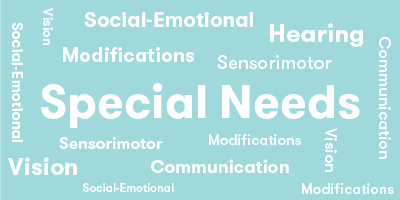
Cognitive
Suggestions for How to Modify Play Experience
Play with 2-3 cards in a hand. This will allow the child to see the options more easily and have fewer options to consider.
Allow game play without having to make a food piece swap. If the existing grill components are good when it is the player's turn, the player can play without having to switch pieces.
Allow children with cognitive delays to play with a partner. The partner can then help the child understand the meaning of the cards and help the child move into selecting which pieces to switch.
Communication
Suggestions for How to Modify Play Experience
Encourage players to read the cards aloud that match their grill food pieces.
Understanding the relationship among amounts is a difficult math concept, but it also requires understanding complex relationships within a sentence. Children with language concerns may need to play with a partner until they grasp how to relate the sentences to the pieces on the grill.
Sensorimotor
Suggestions for How to Modify Play Experience
The grill pieces are thick, so may be able to be moved relatively easily. The cards, however, may present a challenge for children with fine motor concerns. Use a card holder made from thick paper or thin cardboard to make a vertical ledge to hold the cards. Another player can remove and add cards to the holder. If needed, another player can also switch the food pieces.
Social Emotional/Behavioral
Suggestions for How to Modify Play Experience
To reduce frustration, allow game play without having to make a food piece swap. If the existing grill components are good when it is the player's turn, the player can play without having to switch tiles if desired.
Modify the game so players are not allowed to take pieces from other players. This reduces the potential frustration of having someone take the child's pieces they were hoping to use for the next move.
Vision
Suggestions for How to Modify Play Experience
Differentiating the foods on the cards may be difficulty for some children with vision concerns. Print on the cards is in white against a dark background, providing good contrast. The print is in capital letters, but the print is not large. The game may be too challenging for visually impaired children.
Hearing
Suggestions for How to Modify Play Experience
Children can hold up the cards that illustrate their Grill piece amounts, and sign or gesture if needed.
*Data compiled from CCSSI ELA Standards, WA Science Standards, and Washington Social Studies Standards

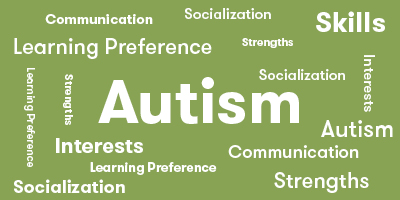
Autism Strengths & Interests
Short Summary of Strengths & Interests
- Likes food or cooking.
- Is good at relative math concepts like "less than".
- Likes to make matches between ideas and visuals.
Is good at matching visual items
Is This Game Appropriate? Yes
Description
Grill Party requires visualizing what was read on the cards and being able to match the meaning to what is seen on the grill. This is not a visual match, but rather a concept to visual match.
Children who understand what they read will be able to identify a visual match.
Has a good memory for sensory details, including visual, touch, taste and smell
This game is not appropriate
Has a good memory for words, phrases and dialouge
Is This Game Appropriate? Yes
Description
The child has to remember the meaning of the words on the cards, such as "more" and "than" and relate them to the phrase on the card, "More X than Y", and then relate that to the visual of the objects on the grill. The child who has a good memory for these concepts will do well with the game.
Has a good memory for pictures, numbers and patterns
Is This Game Appropriate? Yes
Description
The players have to recreate the pattern listed on the cards they select. Using real pictures of objects will enable children with autism to have a concrete way of demonstrating meaning.
Likes to put things in order or a sequence
This game is not appropriate
Learns through visualizing or "replaying" actions in their mind
This game is not appropriate
Likes activities with rules, such as math and phonics
Is This Game Appropriate? Yes
Description
Grill Party requires players to understand relative values like "more than" and "less than". Many children with autism enjoy math because of the underlying logic and rules. Children with this preference will be able to use those skills to great advantage while playing the game.
Is very concrete and literal
Is This Game Appropriate? Yes
Description
Some children with autism prefer concrete or literal activities. Grill Party is good for children with this preference and skill, since players need to trade pieces every turn in order to maximize the amount of cards they can discard. Also, the images on the cards clearly relate to the game pieces.
Learns in small "chunks" (for example, phone numbers are 3 chunks of number xxx-xxx-xxxx that are combined together)
This game is not appropriate
Is good at nonverbal reasoning and logic
This game is not appropriate
Likes spatial problem solving
This game is not appropriate
Can read well with good vocabulary, though may not fully comprehend content
Is This Game Appropriate? Yes
Description
While the Grill Party is not a "reading" game, players do need to be able to read the directions on the card, such as More Corn Than Fish, and understand what the card means.
Likes to use and has good fine motor skill
This game is not appropriate
Likes established routines or set ways of doing things
This game is not appropriate
Likes manipulating, constructing or building things
This game is not appropriate
Likes to use and has good musical abilities
This game is not appropriate
Likes to use and has good drawing skills
This game is not appropriate
*Data compiled from CCSSI ELA Standards, WA Science Standards, and Washington Social Studies Standards

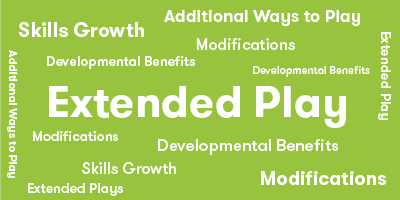
Extra Ways to Play the Game
Make the game into a team challenge. Have each team randomly draw four food pieces from the box lid (held above eye level). Draw one card from a random set of twenty cards and place it to the side of the grill. Each team then tries to get the grill to match the card. The first team to match the grill to the card wins the card. When all twenty cards are gone, the team with the most cards wins. Note: sabotage can be an additional element. Players can see what the other team's food pieces are and may choose to sabotage their next turn if they cannot win the card themselves.
Materials Needed
No additional materials needed.
Developmental Benefits
This modification encourages discussion of play options. Players also have an opportunity to analyze opponents' pieces and think about how to block a card win.
Extra Ways to Play the Game
Modify the game so players are not allowed to take pieces from other players.
Materials Needed
No additional materials needed.
Developmental Benefits
This simplifies the game and makes it less frustrating for children who have a low frustration tolerance.
*Data compiled from CCSSI ELA Standards, WA Science Standards, and Washington Social Studies Standards
Game Details
- 1 Grill Board
- 1 Flame Board
- 24 Grill Food Pieces
- 100 Grill Food Cards
- 1 Rules Booklet
- Choosing a selection results in a full page refresh.
- Opens in a new window.













